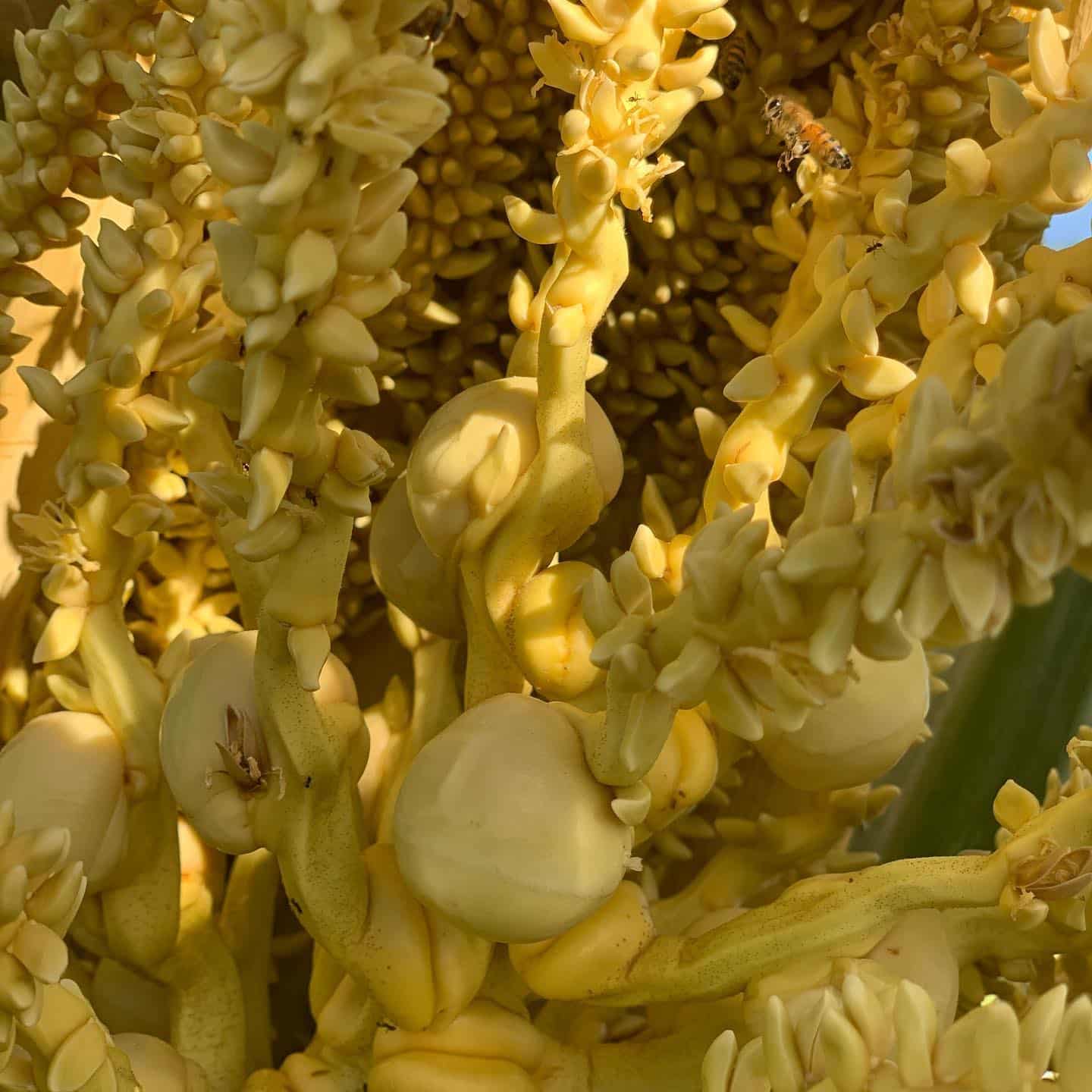It is obvious that coconut flower turns into fruit, but is it edible and has any benefits?
If you want to learn more about coconut flowers and their edibility, keep reading this article!
Table of Contents Show
All About Coconut Flowers
Coconuts produce flowers in a cluster with spadix, which mimics the long and fleshy stem. Also, the spadix is covered in a spathe that is in the boat-shaped bract.
Coconut flowers are in white cream color with 1-2 inches in diameter. They bloom throughout the year but mostly flower in the rainy seasons.
The flowers also produce a sweet, floral fragrance along the nectar, for which bees and other pollinators visit the flowers.
You can eat the coconut flowers as fresh, cooked, or dried. These flowers serve several edible items such as salads, stir-fries, curries, and other dishes.

Besides, you can use coconut flowers to prepare desserts, including waffles, pancakes, and ice cream.
Here are some ideas to use and eat coconut flowers.
- Look for coconut flowers that are fresh and well-scented. Avoid the flowers if they are wilted or black and brown in color.
- Gently wash the coconut flowers and rinse them thoroughly.
- You can eat the whole of the flowers if they are young. If mature, you need to slice or dice the flowers.
- Fresh coconut flowers can be good in condition if stored in the refrigerator for 3 days. Also, dried flowers can last for 6 months if stored in a cool place.
What are the Benefits of Coconut Flowers?
As coconut flower is edible, it offers a pack of benefits.
1. Nutritional Content
Coconut flowers are a good source of vitamins, including vitamins C, B1, B2, B3, and B6. Besides, minerals and antioxidants also add to the benefits of the flowers.
Here is the table for more information!
| Nutrient | Amount per 1/4 cup (28 grams) | Percent Daily Value (%DV) |
|---|---|---|
| Calories | 120 | 6% |
| Carbohydrates | 18 grams | 6% |
| Sugar | 6 grams | 7% |
| Fiber | 10 grams | 36% |
| Protein | 6 grams | 12% |
| Fat | 3 grams | 5% |
| Iron | 1.08 mg | 6% |
| Potassium | 200 mg | 6% |
| Sodium | 15 mg | 1% |
2. Dealing with Diabetes and UDTs
Diabetes is a long-term health issue, so consuming coconut flowers can help keep it under control by satisfying insulin sensation.
Also, if you have unitary tract disorder, eating these flowers helps with it.
A diet that keeps the acid and alkaline components in balance is really beneficial for UTD patients. And sprouted coconut flowers possess additional minerals.
3. Heals Diarrhea & Dysentery
In tropical regions, people cool down the rising temperature over the body by drinking coconut water.
In the meantime, excess heat causes many health problems, including diarrhea and dysentery.
So, consuming the coconut sprouts can help you deal with these health issues.
You can better brew these flowers in water and enjoy the sip in the morning.
4. Prevent the Risk of Heart Diseases
Coconut flowers possess lauric acid that helps raise HDL (beneficial) cholesterol levels and lower LDL (harmful) cholesterol levels.
Besides, they help regulate blood pressure by providing the body with potassium and minerals.
These flowers are also rich in antioxidants to improve blood flow and reduce inflammation, which overall subdue the potential risk of heart diseases.
5. Helps in Weight Loss
It is true that coconut flowers act as appetite suppressants by providing enough nutrition intake, including vitamins and minerals with low calories and high fibers.
Also, they boost metabolism and help burn calories to shed unnecessary fats.
This way, you can get a beautiful and shaped body under a healthy weight.
From Editorial Team
Do Coconut Trees Produce Fruit If You Cut Flowers?
Simply no. To bear fruit, coconut trees need fertilized ovaries of the coconut flower, which are later pollinated.
So, you must sacrifice coconut fruit to leverage flowers and vice versa.


